As an Amazon Associate I earn from qualifying purchases.
There are very, very few things in the world I love more than a perfectly cooked, bone in ribeye steak. It's succulent, juicy, and packed full of flavor. This recipe is going enhance that flavor subtly with garlic, thyme and butter without overtaking it.
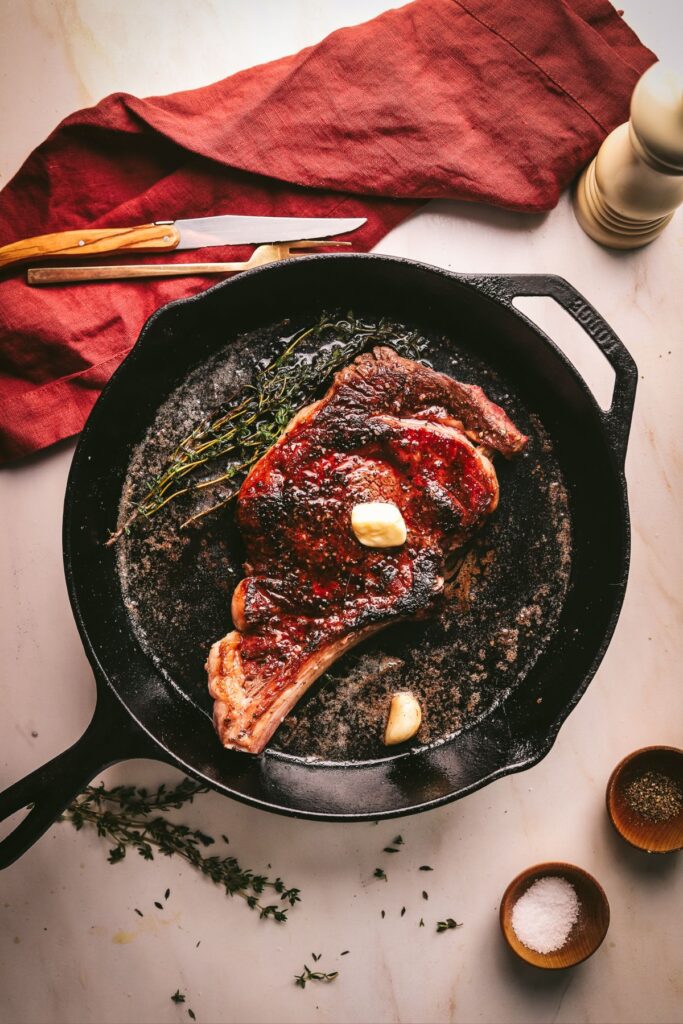
Elevate your grilling game with a pan seared, bone-in beef ribeye steak! Unleash the best, most intense flavors and succulence with the perfect sear on a premium cut of meat. It's also pretty quick and easy!
While this post is focusing on the perfect pan-sear, I also have a detailed guide about how to grill the perfect ribeye! And - a ribeye works great as a steak to reverse sear.
Jump to:
- Why You're Going To Love This Recipe
- Sirloin Steak vs. Ribeye Steak
- Ribeye Steak vs. New York Strip
- What to Look for in a Good Ribeye
- What I Tested that Didn't Work
- Ingredients
- How to Make a Bone In, Ribeye Steak
- Internal Temperature for Ribeye
- Pro Tips and Tricks
- Serving Suggestions
- Frequently Asked Questions
- More Amazing Steak Recipes
- 📖 Recipe
Why You're Going To Love This Recipe
Juicy Perfection: The bone-in ribeye guarantees a succulent, moist experience.
Classic Foundation: Salt and pepper create the ideal flavor base.
Herb Infusion: Garlic, thyme, and rosemary elevate the taste to a savory delight.
Luxurious Finale: A buttery basting at the end adds a touch of culinary indulgence.
Carnivore's Dream: This recipe is a flavor-packed symphony for meat lovers.
Sirloin Steak vs. Ribeye Steak
Sirloin Steak: It comes from the sirloin primal, a well-exercised area, resulting in a leaner cut with less intramuscular fat. This makes it a healthier option for those watching their fat intake. The sirloin is typically divided into top sirloin and bottom sirloin. The top sirloin is more tender and suitable for grilling, while the bottom sirloin may require marinating or slower cooking methods.
On the other hand, the ribeye steak hails from the rib section, closer to the front. It's known for its rich marbling, the ribeye has a succulent and robust flavor. The intramuscular fat enhances tenderness and juiciness, making it a favorite among steak aficionados. The eye of fat within the meat adds amazing texture, and when properly cooked, it practically melts in your mouth.
Ribeye Steak vs. New York Strip
While the ribeye dazzles with its rich marbling, the New York Strip impresses with a more straightforward, meaty character. If you're in the mood for a buttery texture and intense beef flavor, go ribeye. For a leaner option with a bold taste, the New York Strip is your culinary companion.
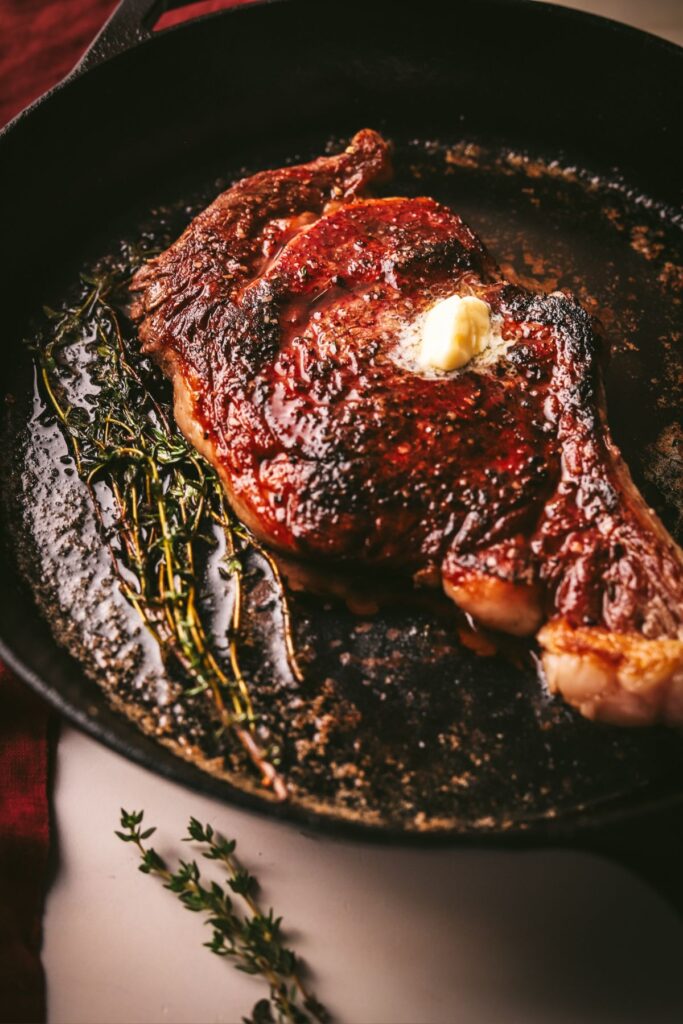
What to Look for in a Good Ribeye
Marbling: Abundant intramuscular fat ensures flavor and tenderness.
Rich Red Color: Vibrant, not dull, indicates freshness and quality.
Thickness Matters: Opt for a thick cut for juiciness and even cooking. I usually go for at least an inch and a half thick.
Well-Defined Edges: A clean, well-trimmed edge signals attention to detail.
Firmness with Flexibility: Press gently; it should bounce back without feeling too firm.
Uniformity: Consistent thickness ensures even cooking throughout.
What I Tested that Didn't Work
Bone in is the way to go: I have cooked hundreds of ribeye steaks in my life. And while cooking without the bone is still good, the bone adds a ton of flavor.
Simple Seasoning: As much as I love a good steak rub, when we're basting with herbs and garlic, I find that a simple salt and pepper is totally the way to go for this recipe. There's no need to get fancy with it - plus we want the meat flavor to shine here.
Don't go too thin: One of the keys to perfectly cooking this steak is making sure it's thick enough that you don't over cook it. I find that the cuts you get off the grocery store shelf are often too thin. You're looking for about an inch and a half to two inches in thickness. If you can't find it on the shelf, ask your butcher to cut one for you.
Ingredients
Bone-In Ribeye: The star! The bone enhances flavor and retains juices during cooking, ensuring a succulent steak.
Salt and Pepper: The dynamic duo. They season the meat, enhancing its natural flavors without overpowering.
Garlic: Adds depth and complexity, complementing the beefy richness with its savory notes.
Thyme and Rosemary: A herbaceous blend that infuses the steak with earthy, aromatic tones, creating a well-rounded flavor profile.
Butter: The finishing touch! Basting with butter adds a luscious, velvety texture and enhances the overall richness of the dish.
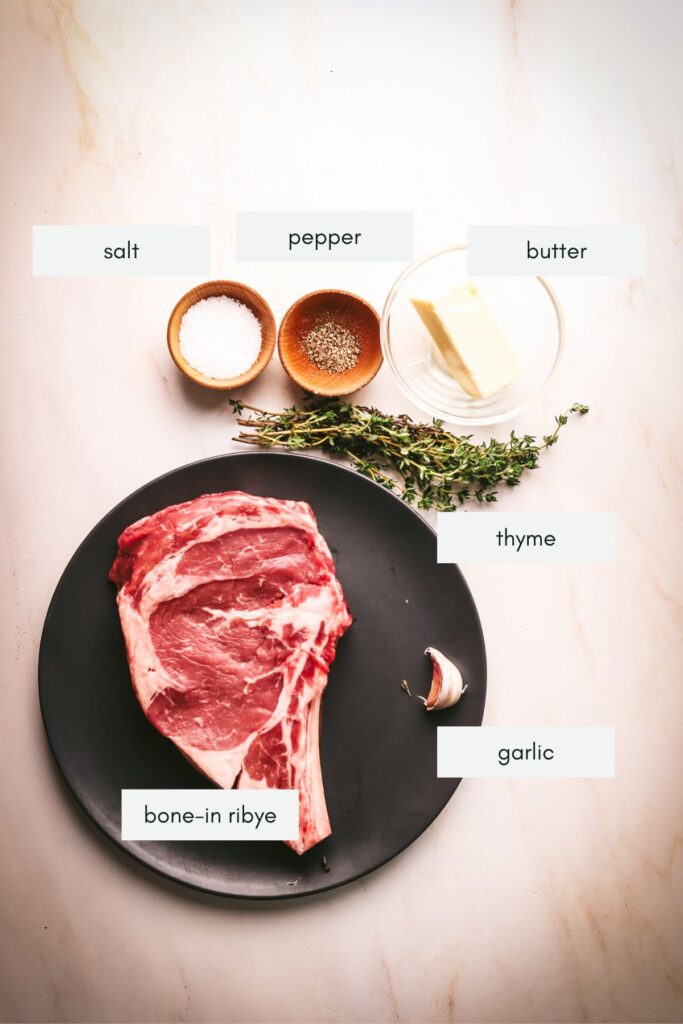
How to Make a Bone In, Ribeye Steak
Prep the Ribeye:
Bring the ribeye to room temperature for even cooking.
Pat it dry with paper towels to ensure a good sear.
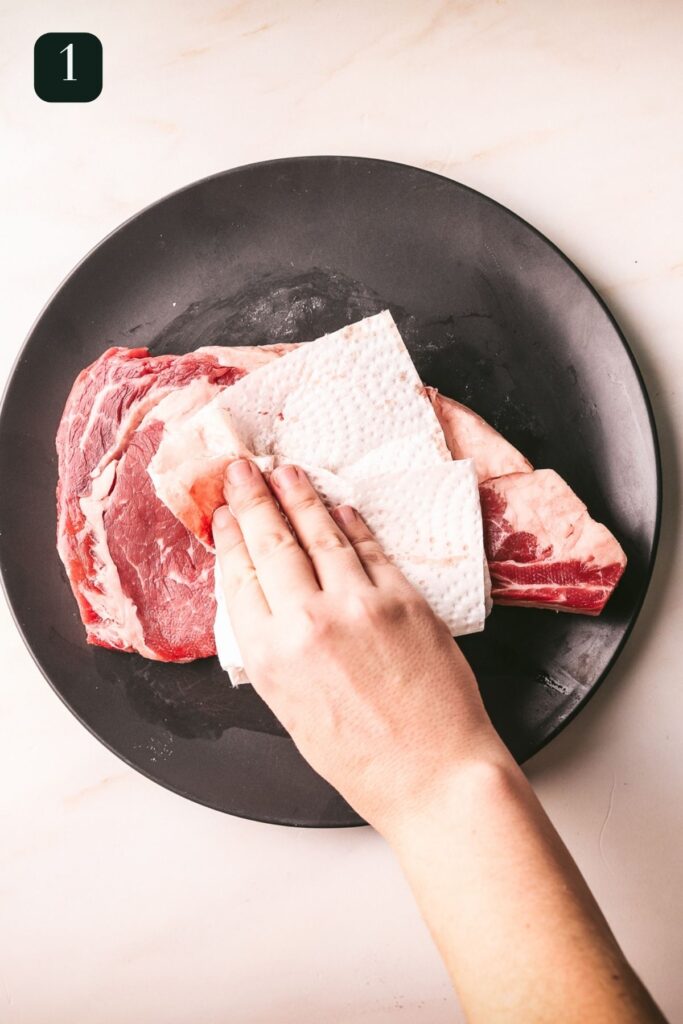
Seasoning:
Season liberally with salt and pepper on both sides.
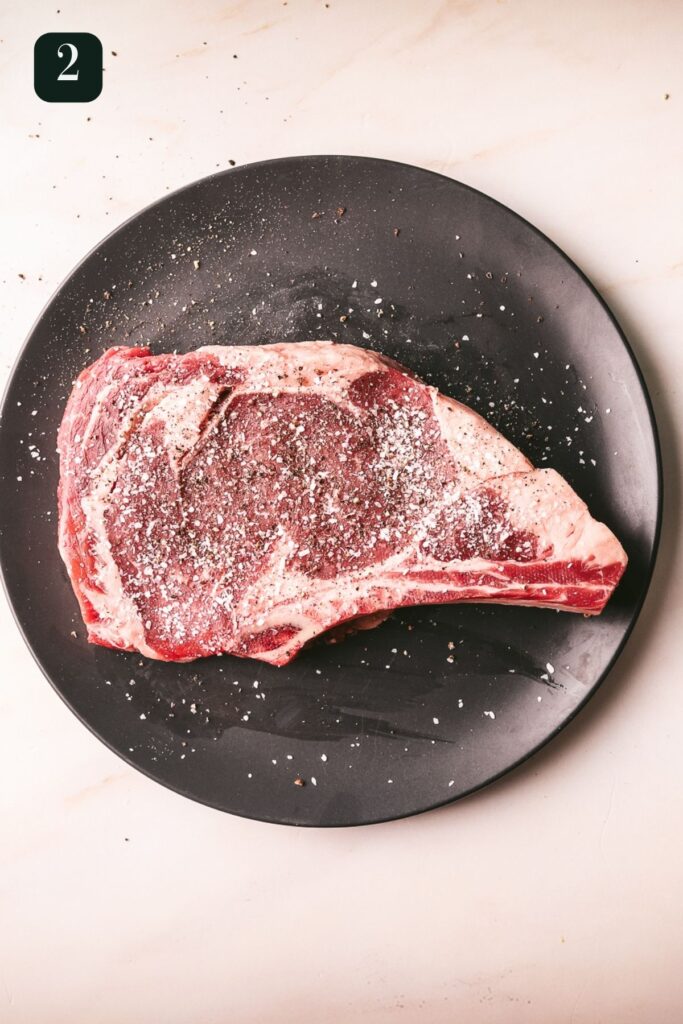
Searing:
Heat a cast-iron skillet or grill pan over high heat. It should be absolutely smoking hot - you should hear a good sizzle when the steak goes in. If it doesn't do that, the pan is too cold.
Sear the ribeye on each side for 2-3 minutes until a golden crust forms.
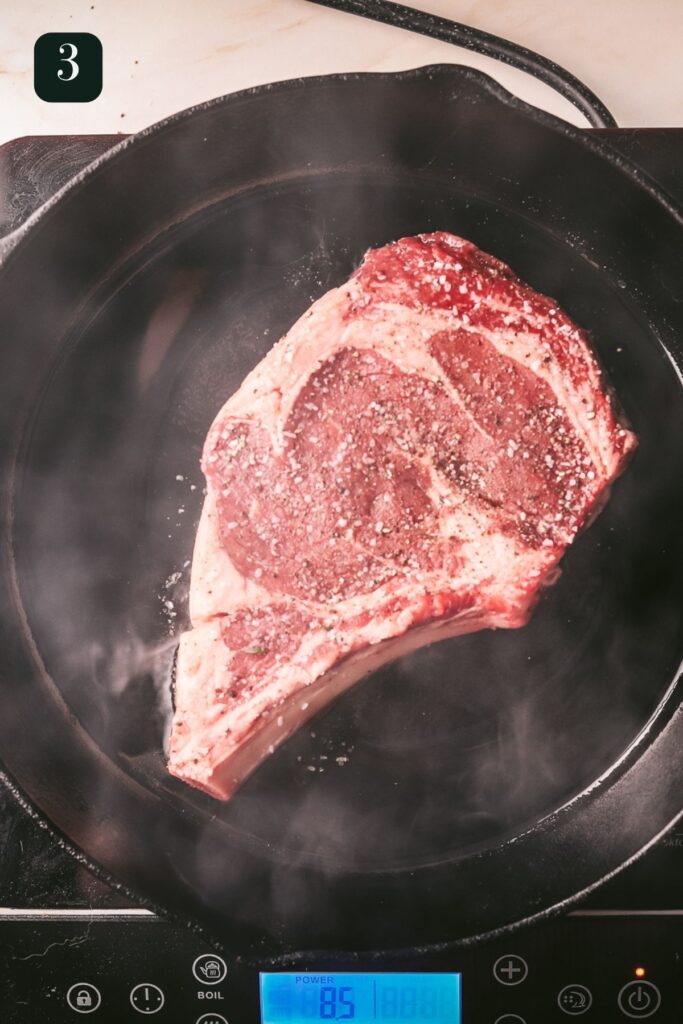
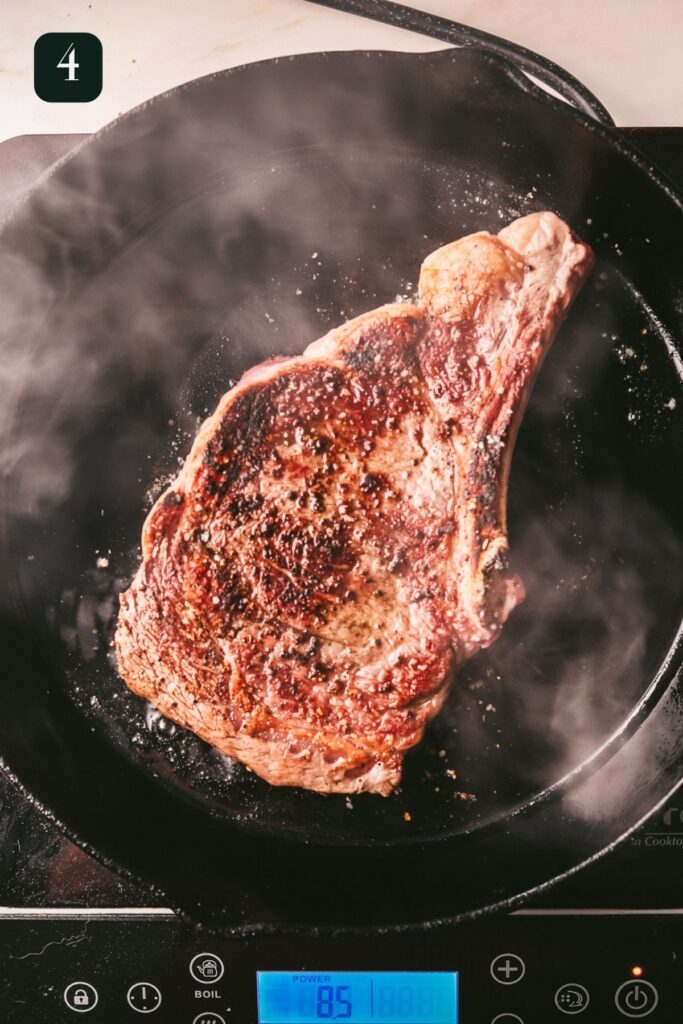
Herb and Butter Infusion:
In the last minute of searing, add minced garlic, thyme, and rosemary to the pan. Add a generous knob of butter to the pan. Baste the steak with the infused flavors.
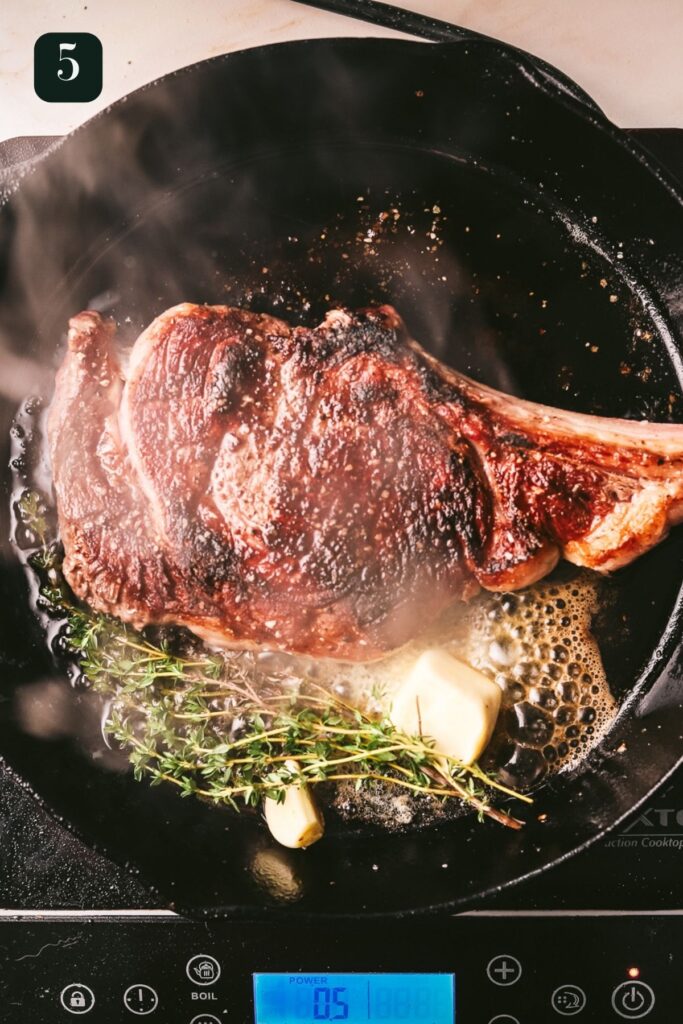
Finishing in the Oven (Optional):
If desired, transfer the skillet to a preheated oven at 375°F (190°C) for additional cooking to reach your preferred doneness. I rarely need to do this - your steak is going to be really thick if you have too. Make sure you use a meat thermometer to check your temperatures! That's the only super accurate way to make sure it's cooked to perfection.
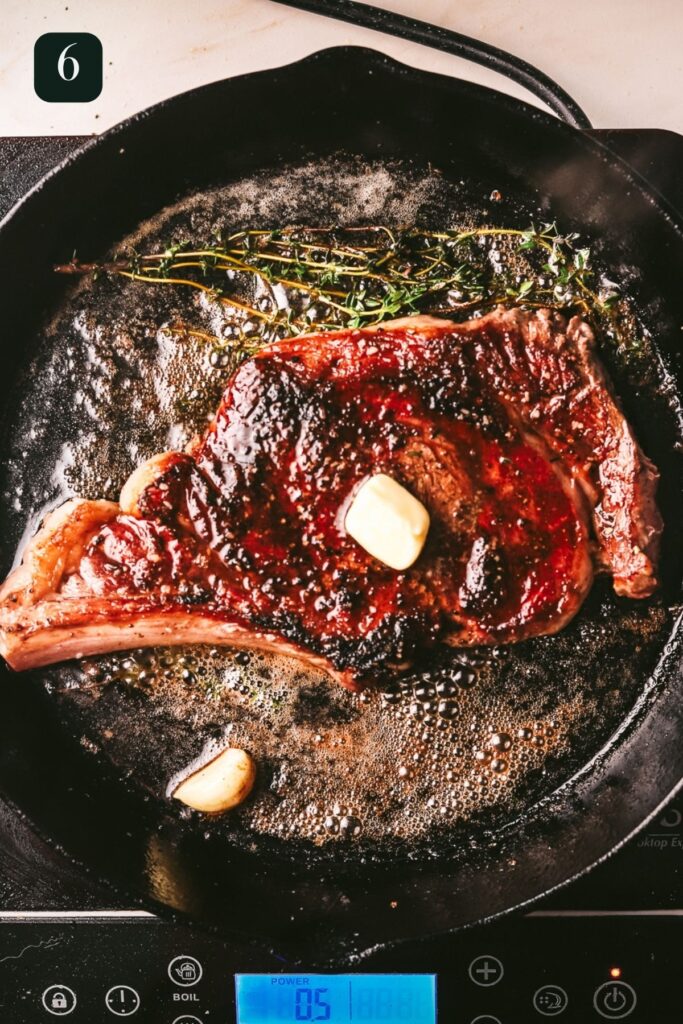
Rest and Serve:
Let the ribeye rest for a few minutes before slicing.
Drizzle with any remaining pan juices and serve.
Internal Temperature for Ribeye
For optimal texture and flavor in a ribeye, you should be eating it medium rare. This is how almost any chef would suggest it be cooked. However, if that isn't your jam, this temperature cooking time chart can help you reach your desired doneness. This can be a tricky prospect, so if you need some more tips and tricks, check out this handy steak internal temperature guide.
| Doneness | Internal Temp (°F) | Sear Time (minutes) (per side) |
|---|---|---|
| Rare | 120-125 | 2-3 |
| Medium Rare | 130-135 | 3-4 |
| Medium | 140-145 | 4-5 |
| Medium Well | 150-155 | 5-6 |
| Well Done | 160°F and above | 6-7 |
Pro Tips and Tricks
Quality Matters: Invest in high-quality, well-marbled bone-in ribeye steaks for the best flavor and texture.
Temper Before Cooking: Allow the steaks to come to room temperature before cooking to ensure even cooking throughout. This is super important for being able to control the cooking temperature of the steak.
Dry Before Searing: Pat the steaks dry with paper towels before seasoning to encourage a better sear.
Hot Surface for Searing: Ensure your skillet or grill pan is screaming hot before placing the steaks to achieve a golden crust.
Mind the Thickness: Adjust cooking times based on the thickness of your steaks. Thicker steaks may require additional time in the oven. (See the chart above for guidance).
Rest for Juiciness: Allow the steaks to rest after cooking to let the juices redistribute, ensuring a juicy bite.
Experiment with Finishing Touches: Try finishing the steaks with a sprinkle of flaky sea salt or a drizzle of high-quality olive oil for an extra layer of sophistication.
Use a Meat Thermometer: For precision, use a meat thermometer to check the internal temperature and achieve your desired level of doneness. I've said it once, I've said it a thousand times. This is a NECESSITY for cooking steaks. Unless you're maybe Gordon Ramsey.
Serving Suggestions
A good steak needs some good sides to hold up to it. Here are a few suggestions:
Truffle-infused Mashed Potatoes:
Elevates the meal with a luxurious and earthy flavor, complementing the richness of the ribeye.
Offers a vibrant and citrusy contrast, refreshing the palate between each succulent bite of the ribeye.
Roasted Brussels Sprouts with Maple Glaze:
Provides a sweet and tangy element, balancing the savory notes of the ribeye and adding a delightful caramelized crunch.
The mild, buttery flavor of Brie enhances the overall richness of the dish without overpowering the main course, allowing the ribeye to shine.
How About Some Wine Pairings?
Pair your ribeye with a bold red wine like Cabernet Sauvignon or Malbec. The robust flavors in the wine complement the richness of the ribeye, creating a beautiful and delightful dining experience.
Frequently Asked Questions
It depends on your preferences, but this butter basted, herb and garlic infused version is definitely up there!
It depends on how you like it done. For rare, sear 2 minutes per side. Medium rare, 3 minutes, medium, 4 minutes, medium well, 5 minutes, and well done, 6 minutes plus. But it really depends on the thickness of your steak. The best way to know is to use a meat thermometer!
The bone-in ribeye is sourced from the rib primal of the cow, situated between the chuck and the loin.
Dry-aged ribeye is often considered worth it for those who appreciate a more intensified and complex flavor in their steak. During the dry-aging process, the beef undergoes controlled dehydration and enzymatic breakdown, resulting in a concentration of flavors and a tenderization of the meat.
Ribeye is pricier due to its high marbling, popularity, and limited quantity per animal, making it a premium cut sought after for its rich flavor and tenderness. Factors like cattle quality and the dry-aging process also contribute to its higher cost.
More Amazing Steak Recipes
📖 Recipe

Bone-In Ribeye Steak
Equipment
- Meat thermometer
- oven safe pan
Ingredients
- 1 large bone-in ribeye steak 1½ inches thick
- 1 teaspoon salt or to taste, season as appropriate
- ½ teaspoon black pepper
- 1 tablespoon olive oil
- 1-2 cloves garlic
- 4-5 sprigs thyme
- 3 tablespoon butter
Instructions
- Bring the ribeye steaks to room temperature and pat them dry with paper towels.
- Season both sides of the steaks liberally with salt and pepper.
- Heat a cast-iron skillet over high heat. Add olive oil. Sear the ribeye on each side for 2-3 minutes until a golden crust forms.
- In the last minute of searing, add garlic, thyme, and butter to the pan. Baste the steaks with the infused flavors. Make sure you check the temperature to know when to take the steak off. For medium rare you want to take it out of the pan at 125℉.
- If needed, transfer the skillet to a preheated oven at 375°F (190°C) for additional cooking to reach your preferred doneness.
- Let the ribeyes rest for a few minutes before slicing. Drizzle with any remaining pan juices and serve.
Video
Notes
- Adjust cooking times based on the thickness of the steaks and personal preference for doneness.
- Ensure the pan is hot for a good sear, and use an oven mitt when transferring the skillet to the oven.
- Experiment with different herbs or a sprinkle of finishing salt for added flair. Enjoy your perfectly seared bone-in ribeye!
Nutrition
Hi, I'm Cara! I'm a food writer, journalist, and recipe developer. I'm obsessed good food, good wine, good cocktails and entertaining. I've picked up a few tips over the years, and love sharing them with others.


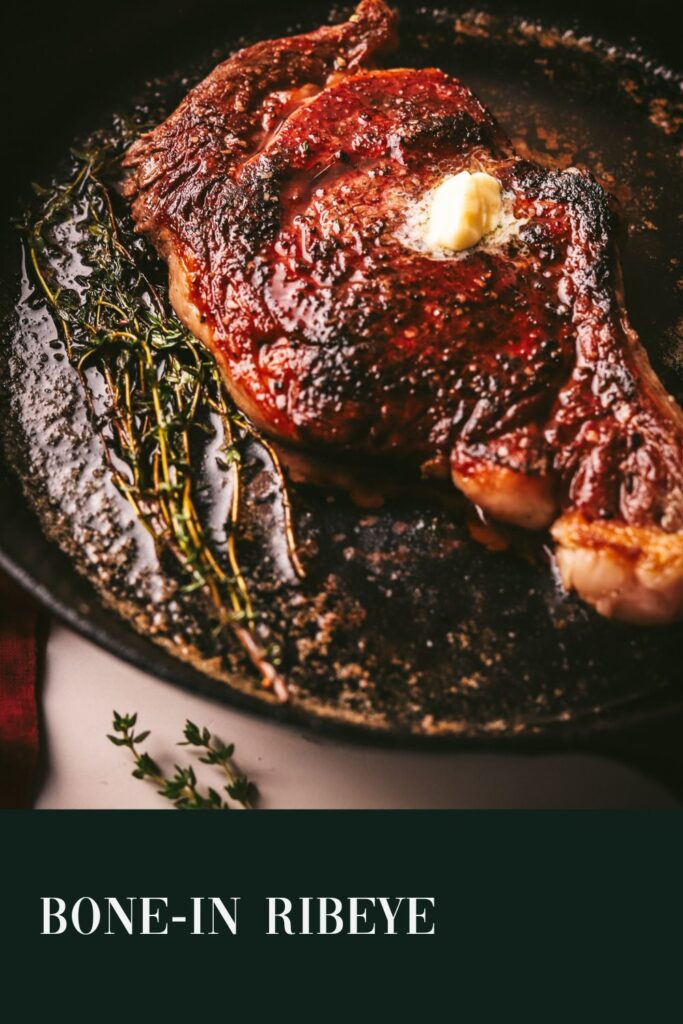
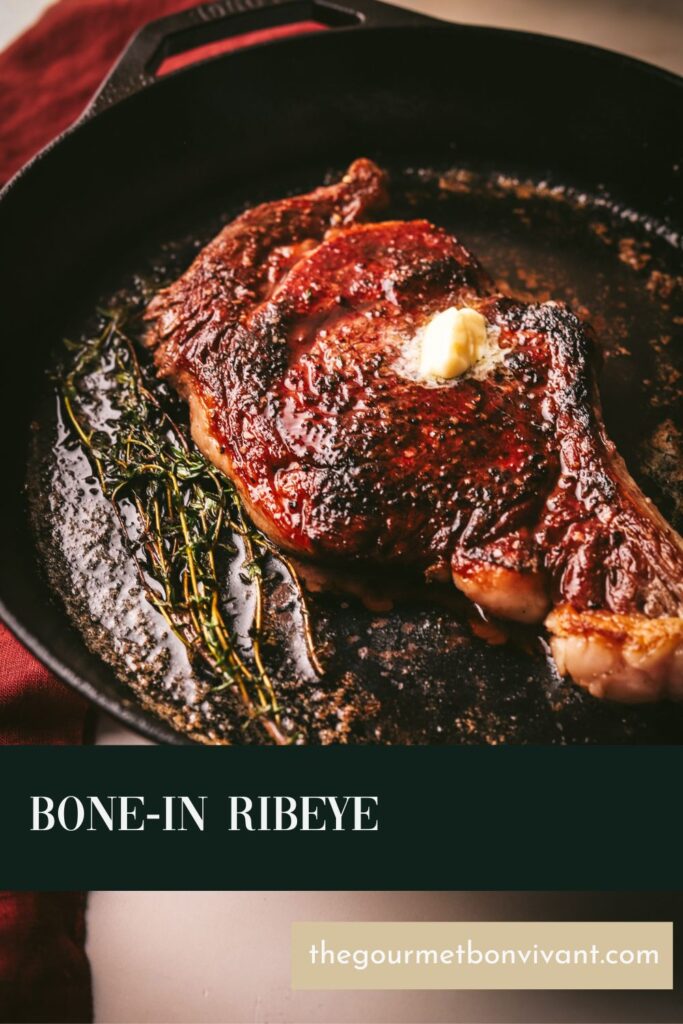
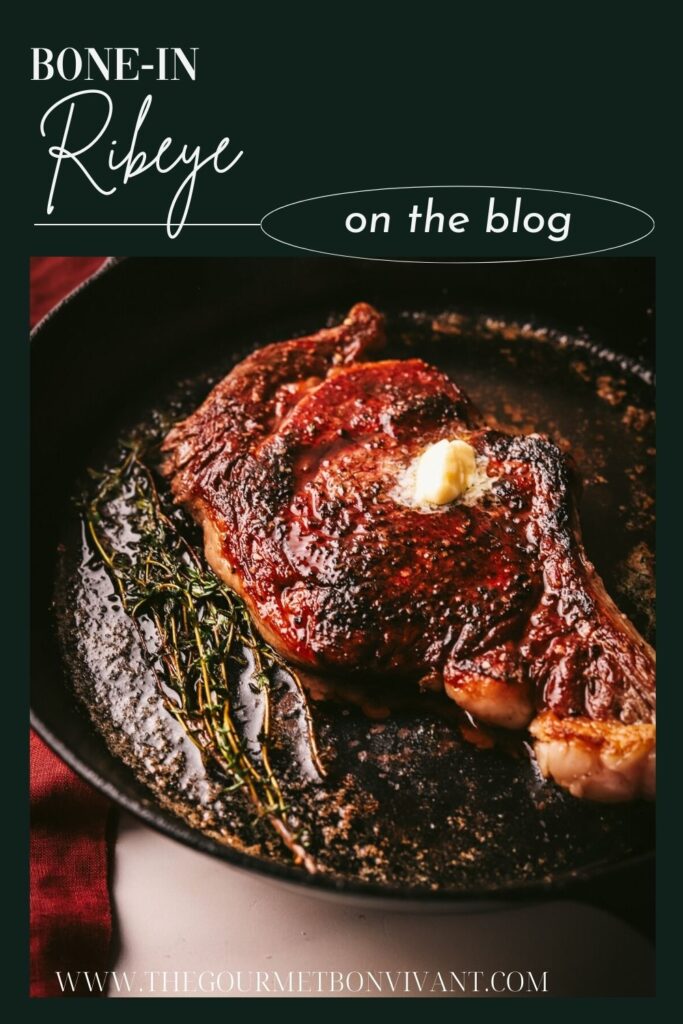
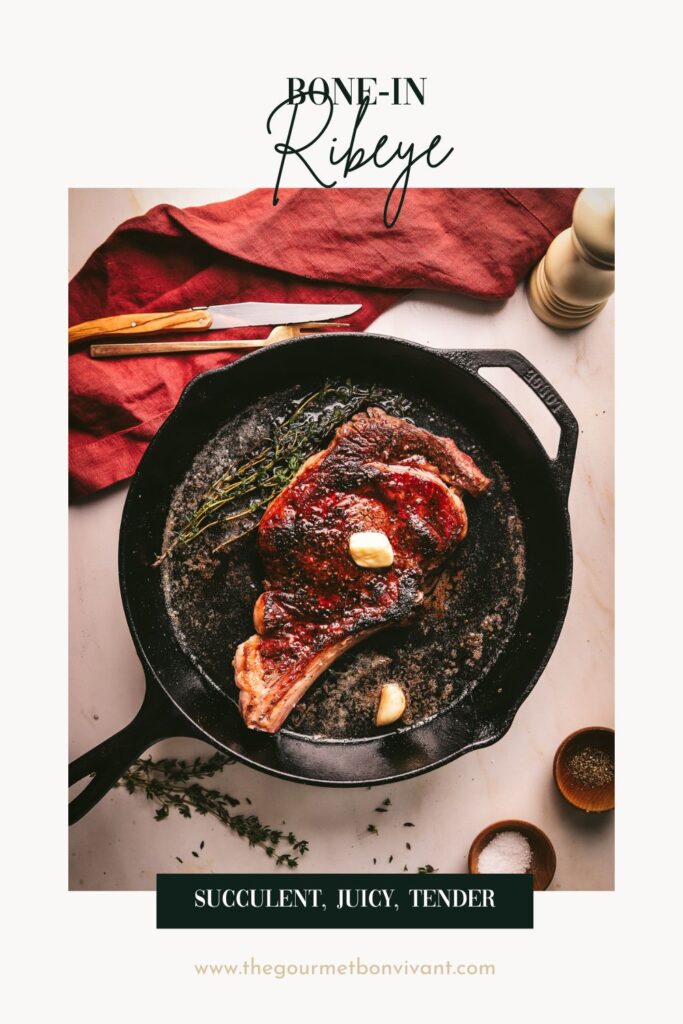

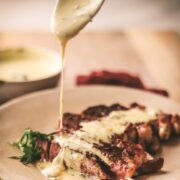
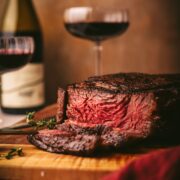
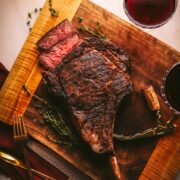

Leave a Reply